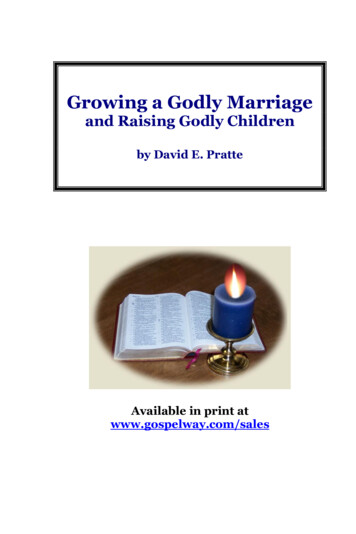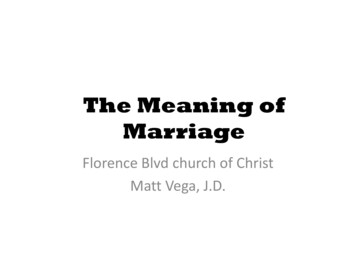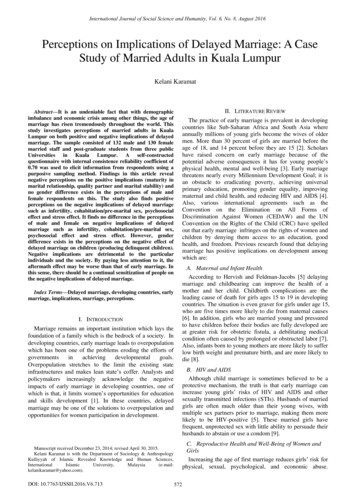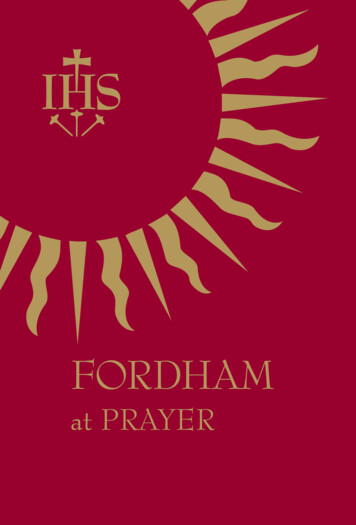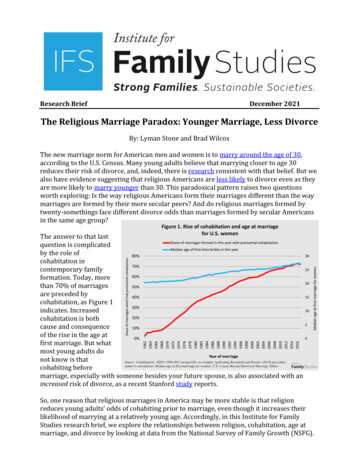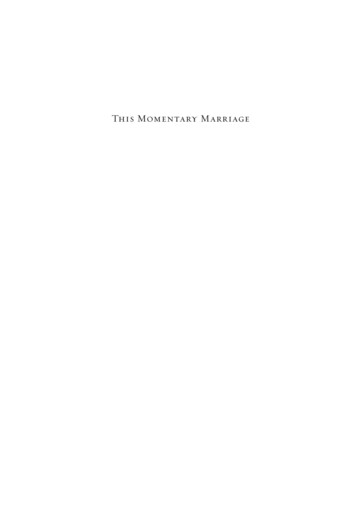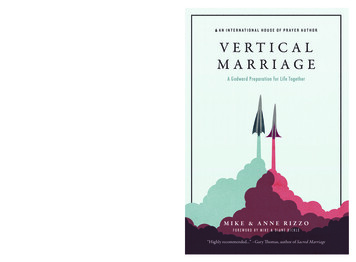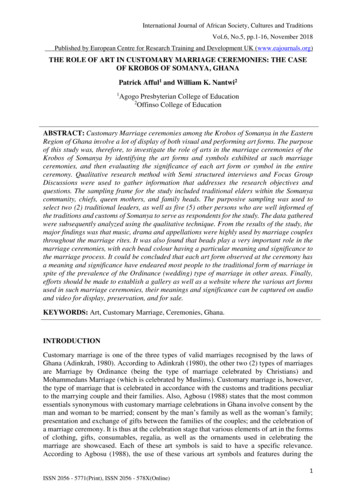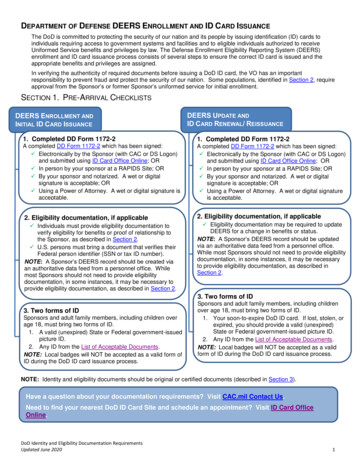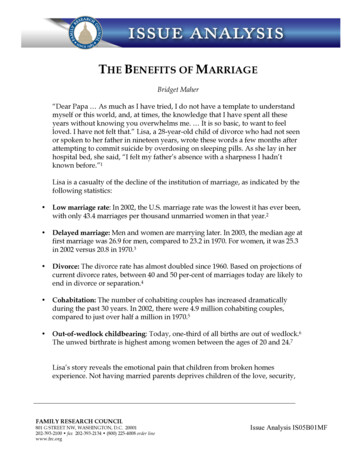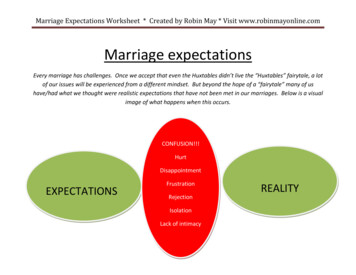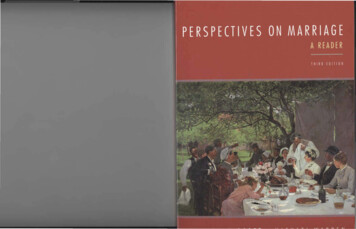
Transcription
Perspectiveson Marriage--AReaderTHIRD EDITIONEdited byKieran ScottFordham UniversityMichael WarrenSt. John's UniversityNew YorkOxfordOXFORD UNIVERSITY PRESS2007
ContentsChapter 7COrJ1ENTSAcknowledgmentsV1111IntroductionPART ONEMarriage in Historical PerspectiveChapter 1Marriage in the BibleMichael G. Lawler22Chapter 3Marriage: A Historical SurveyJoseph Martos29PART TWOContemporary Perspectives on the Theology of MarriageChapter 5"Nuptial Pentecost": Theological Reflectionson the Presence and Action of the Holy Spiritin Christian MarriageJulie McCarty7183PART THREEMarriage: Meanings and TransitionsChapter 6Marriage versus Living TogetherfoMcGowanChapter 8Cohabitation and Marriage as a Life-ProcessKieran Scott114Chapter 9The Meaning of MarriageEvelyn Eaton WhiteheadJames D. Whitehead124Chapter 10 The Meaning of Marriage: Of Two MindsEdward C. Vacek134Chapter 11 Same-Sex Marriage: Threat or Aspiration?Stephen J. Pope141Chapter 12 Marriage Becomes a JourneyEvelyn Eaton WhiteheadJames D. Whitehead147PART FOURThe Primitive Christian Understanding of MarriageTheodore Mackin, S.J.Christian Marriage: Basic SacramentBernard Cooke1027Chapter 2Chapter 4Marriage Preparation and Cohabiting Couples:Information ReportNCCB Marriage and Family Committeev97Attitudes toward SexualityChapter 13 Sex Matters: The Riches of the Catholic Sexual TraditionSidney Callahan161Chapter 14 A Revolution's Broken PromisesPeter Marin167Chapter 15 Passionate Attachments in the West inHistorical PerspectiveLawrence Stone176Chapter 16 Four Mischievous Theories of Sex: Demonic, Divine,Casual, and NuisanceWilliam F May186Chapter 17 The Neglected Heart: The Emotional Dangers ofPremature Sexual InvolvementThomas Lickona196Chapter 18 Sex, Time, and Meaning: A Theology of DatingJason KingDonna Freitas207Chapter 19 Beyond Romance to Human LoveRobert A. Johnson222Chapter 20 The Transmission of LifePope John Paul IJ230
ContentsviPART FIVECommunication, Conflict, and ChangeChapter 21 How People ChangeAllen WheelisChapter 22 "Put Down That Paper and Talk to Me!":Rapport-Talk and Report-TalkDeborah Tannen239244Chapter 23 Communication and ConflictEvelyn Eaton WhiteheadJames D. Whitehead260Chapter 24 CommunicationThomas N. HartKathleen Fischer Hart268Chapter 25 The Battered Woman: Myths and RealityLenore E. Walker276Chapter 26 Men Who Make Women Want to ScreamConnell CowanMelvin Kinder293Chapter 27 Going to the Therapist En Route to the AltarZoe Wolff301ContentsviiChapter 32 The Meaning of CommitmentMargaret Farley344Chapter 33 Annulment The Process and Its MeaningPatrick R. Lagges357Chapter 34 Remarried Catholics: Searching for Church BelongingJames J. Young367Chapter 35 Divorce and Remarriage in the Catholic Church:Ten ThesesMichael G. LawlerChapter 36 Children after Divorce: Wounds That Don't HealJudith S. Wallerstein374389PART EIGHTSpirituality of MarriageChapter 37 Spirituality and LifestyleEvelyn Eaton WhiteheadJames D. WhiteheadChapter 38 Faithful Becoming: Forming Families in the Art ofParadoxical Living in a Fragmented andPluralistic WorldHerbert Anderson401413PART SIXPART NINEIssues Impacting MarriageChapter 28 Watching New Love as it Sears the BrainBenedict Carey309Chapter 29 You're Getting Married: The Wal-Martizationof the Bridal BusinessRebecca Mead314Chapter 30 Money, Marriage, and Making a Future:The Letter to EmilyMichael Warren326PART SEVENCommitment, Divorce, and AnnulmentChapter 31 What Codl Has Joined Together.335Religious Traditions: Perspectives on MarriageChapter 39 Marriage in the Jewish TraditionBlu Greenberg425Chapter 40 The Protestant View of MarriageWilson Yates444Chapter 41 Marriage in IslamLois Lmnya' Ibsen al Faruqi459
AcknowledgmentsIntroducbanKieran ScottMichael WarrenRobert Miller, executive editor at Oxford University Press, encouraged us toembark on this third edition and patiently navigated us through it. EmilyVoigt, Aleksandra Florek, and Sarah Calabi, editorial assistants, were dedi cated professionals in assisting us in the project. Celeste Alexander, projecteditor for this edition, skillfully and gracefully nurtured the book to comple tion. Drs. Rosemary Bertocci, Brian Doyle, Peter Feldmeier, Patricia BeattyJung, and Arvin Vos offered invaluable suggestions for deletions and addi tions. Ellen O'Rourke worked tirelessly in assembling the final manuscript.Without their generous help, this revised third edition would never havecome to fruition.ith the wide use of Perspectives on Marriage, especially in college- anduniversity-level courses on marriage, we have been asked for a thirdedition, updated with important new material in the four years the 2001 edi tion had been in print. It now appears the reader itself has sparked renewedacademic interest in the question of marriage and in the endless search forwisdom on marriage issues.Readers familiar with the first and second editions will find we havemaintained much material from the second edition and reinstated some im portant essays from the first edition. In doing so, we have been directed bythe many teachers who have given us critical feedback on the previous twoeditions. Research by Oxford University Press into this book's actual use wasinvaluable to us in constructing this new third edition.Perspectives on Marriage remains a "reader" that would be of interest toanyone concerned with marriage at the start of a new millennium. Teachersknow this as they read and reread chapters they have already assigned to pre vious classes and are now assigning them once more. In our view this bookhas particular energy for those teaching "the course on marriage." Studentsseem to flock to such a course, spurred on by their own relationship difficul ties and their desire to understand better the ecstatic yet difficult "love rela tionship." There is so much distortion about erotic relationships today thatsome who come to our classes come as "relationally wounded," searching forsolace and wisdom.Some teachers find the marriage course unfolds easily and often leadsinto intense discussions about the nuances of relationship. The readings hereoffer grounding in research and careful reflection for those discussions. Ourhope is that the material we have provided will be, in reality, an intellectualgift from the writers whose ideas and opinions are found here. The readingsprovide a solid platform for informed Italk about relationships, and evenabout their being a marvelous gift from a loving God.W
IntroductionIntroductionMost teachers of the university-level course in the theology of marriagesee their efforts as an academic enterprise, not a ministerial or church one.They seek to disclose historical traditions, including religious ones, affectingmarriage, while attending to recent social and cultural shifts in attitudes to ward the practice of marriage. Still, an academic course dealing with the re ligious dimensions of marriage will have some things in cornman withchurch efforts in ministry to marriage. One of these is concern for marriagepreparation.Despite the fact that more and more young people have corne to questionwhether a "legal" or formal marriage is necessary or even advisable, studentscontinue to crowd into the theology of marriage courses looking for insightand wisdom about a troubled institution. They know the stakes for them inthis enterprise-however they may choose to approach it-are quite high.Bristling in the midst of our students are all the important dilemmas aboutwhat it means to be alive at this moment in history. Our goal in this reader isto press them with radical questions and humanizing perspectives that haveimportant consequences for their futures. If they become more thoughtfulabout the issues and more constructive about their decisions, our efforts willbe well rewarded.Any course that puts marriage in a religious perspective has the pOSSi bility of contesting some currents in contemporary culture that are hostile toenduring commitments-hostile to the kind of love ethic needed for success ful parenting over the long haul and hostile to the wider networks of supportneeded for families in the future. While some religious assumptions aboutmarriage need critique, many religious convictions offer a radically human izing view of the marital relationship, quite different from some of the depic tions of marriage found in current film and television fare.The readings in this collection contest various assumptions about mar riage, including many recently created by a consumerist culture and somebeing challenged from within religious traditions themselves. Careful read ing will spark earnest, if not heated, discussion and some conflicts over basicpoints of view. Many of the underlying, larger issues cannot be settled in a se mester. 1 We expect many students will leave their courses with lingeringquestions needing continuing reflection: the seeds of emancipatory practice.We recognize the variety of academic levels in what we have gatheredhere. Some readings are historically"dense" and will p.eed careful preteach ing before being read. Others make use of theologically sophisticated con cepts that will also need explanation before becoming accessible to many stu dents. Other fare is less weighty but not less important. We have includedseveral popularizations of first-rate social science scholarship. The ideas andissues in such essays should not be dismissed as "magazine pop psychology"since they make accessible for serious and informed discussion sophisticatedresearch conducted, in some cases, over several years.Our hope is that the resources and ideas found here prOVide some part ofa foundation for joyous, and struggling, life commitments.Those familiar with the first two editions of Perspectives on Marriage willthe deletions and additions that make up this new edition. In some casesreadings have been restored to full length, simplified, or even moved to a dif ferent section. Each reading continues to be followed by questions for dis cussion and, in some cases, titles for further study.Part I, "Marriage in Historical Perspective," brings together a rich set ofmaterials on marriage in the Jewish and Christian traditions. This material isindispensable for acquiring a developmental sense of religious teaching onmarriage.Part 2, "Contemporary Perspectives on the Theology of Marriage," pre sents marriage as a basic Christian sacrament, a sign of God's presence.Part 3, "Marriage: Meanings and Transitions," raises some questionsyoung people have about marriage and offers an approach to marriage as aprocess of growing together.Part 4, "Attitudes toward Sexuality," is the longest section, with severalprovocative readings on the basic assumptions we bring to our relationships.Part 5, "Communication, Conflict, and Change," is presented as a keysection on the issue of conflict and conflict resolution in marriage. All stu dents are familiar with the problems it sets out, but not so many will haveconsidered the kinds of changes in attitudes and behavior it calls for. The dif ference between conflict and violence is a key matter in these readings.Part 6, "Issues Impacting Marriage," looks at some recent scientific re search on romantic love and the role of money in the wedding industry.Part 7, "Commitment, Divorce, and Annulment," acknowledges the fail ure, at times, of the marital ideal and its effects on people's lives. Canonicaland theological perspectives on divorce and remarriage are offered, and thedilemma remarriage poses for Catholics seeking ecclesial belonging is probed.Part 8, "Spirituality of Marriage," explores what it might mean to actu ally live out a deeply religious marriage in a time of consumerism.Part 9, "Religious Traditions: Perspectives on Marriage," is offered forthe many students living in an increasingly multicultural and multireligiousnation who bring to the marriage course questions about interreligiousmarriage.Our metaphor for this third volume is also the wedding ieast, a momentof hope and joy that unity is possible, that the spirit of God can reveal itselfthrough human self-gifting. These readings themselves represent for us akind of intellectual feast on the question of marriage, a question at the heartof what it means to be human.2.:.- . .l . l . ·, . 4-. t. . .b. 7h . t. . t. . ,. .; . . ,. .,:. ,,1'"Y\ fh :;:'P p itit""ll')C-o::::llt'"lrl3NOTE1. See the wise overview of marriage preparation from a religious perspective foundin: Pontifical Council for the Family, "Preparation for the Sacrament of Marriage,"Origins 26:7 (4 July 1996): 97/99-109. A key point in this document is its recognitionthat marriage preparation starts in infancy and continues right up to marriage.
Part 2, "Contemporary Perspectives on the Theology of Marriage," pre sents marriage as a basic Christian sacrament, a sign of God's presence. Part 3, "Marriage: Meanings and Transitions," raises some questions young people have about marriage and offers an approach to marriage as a process of growing together.
